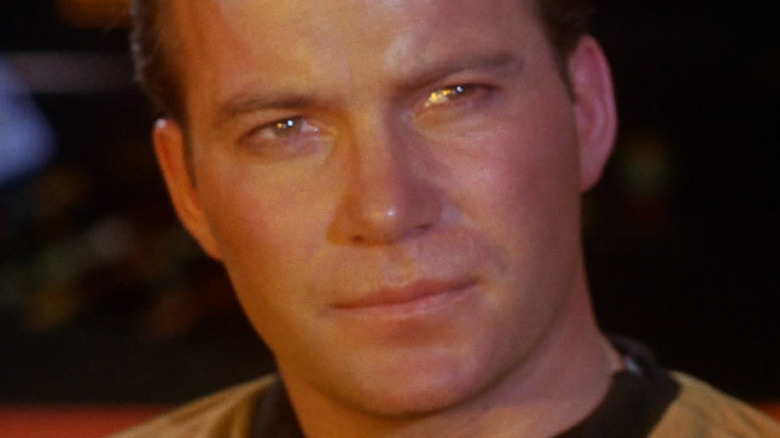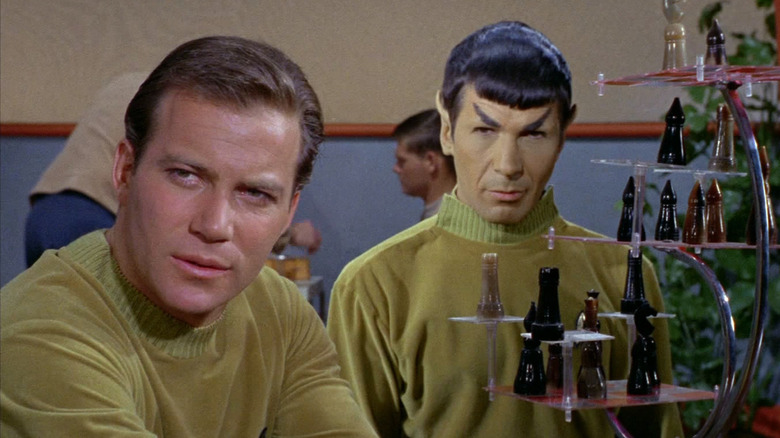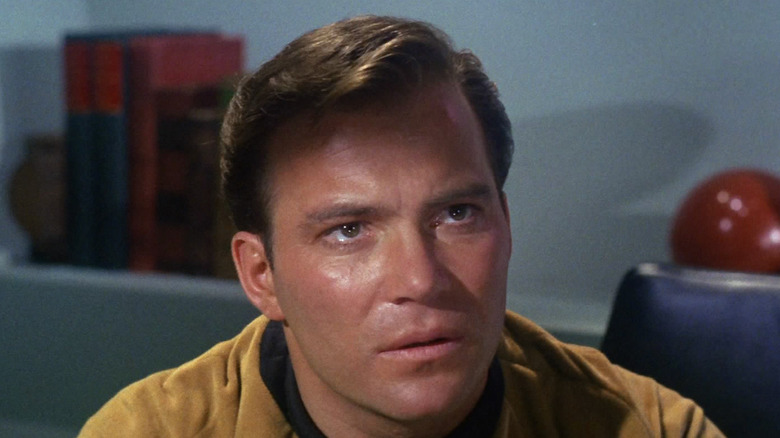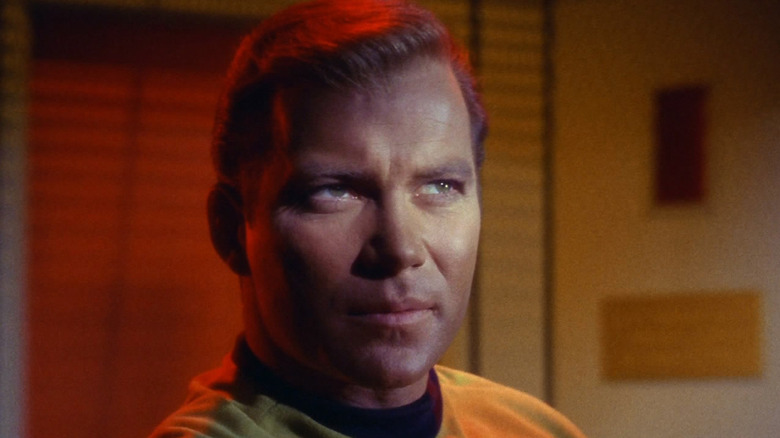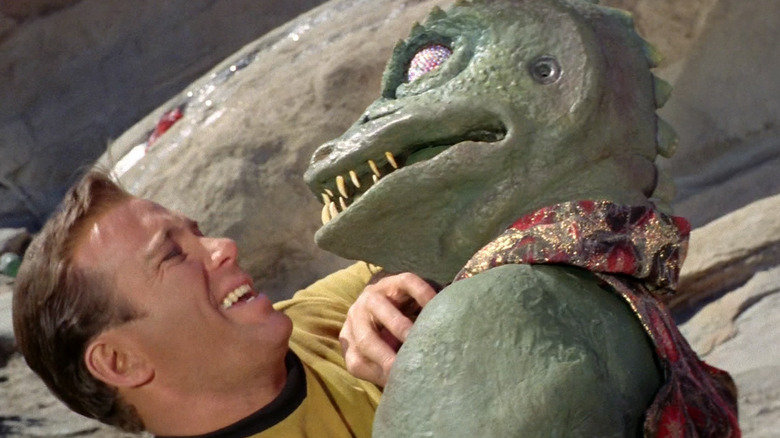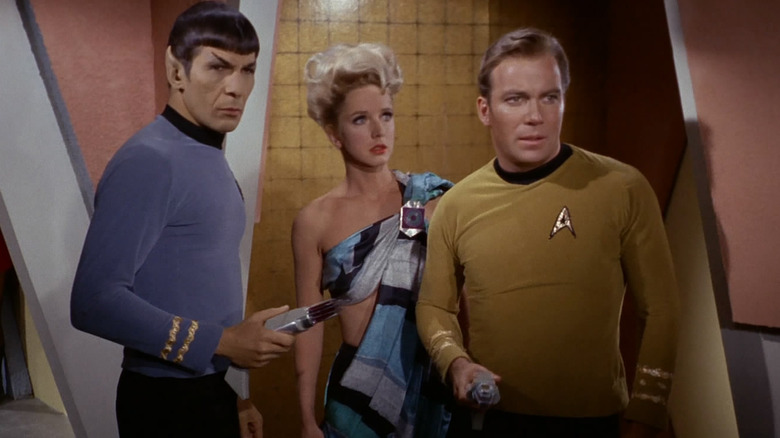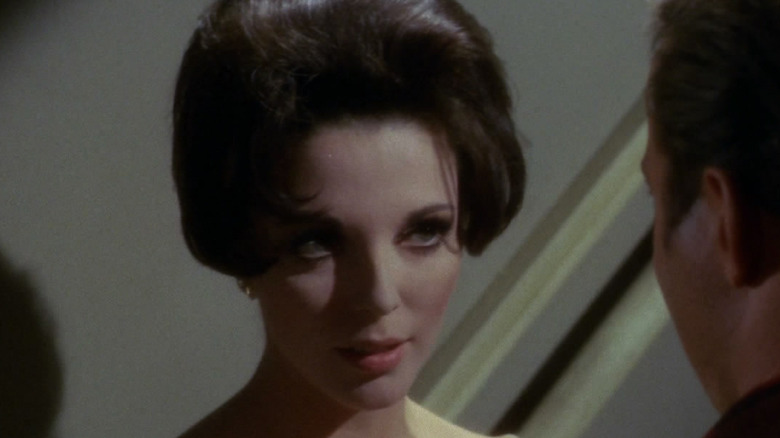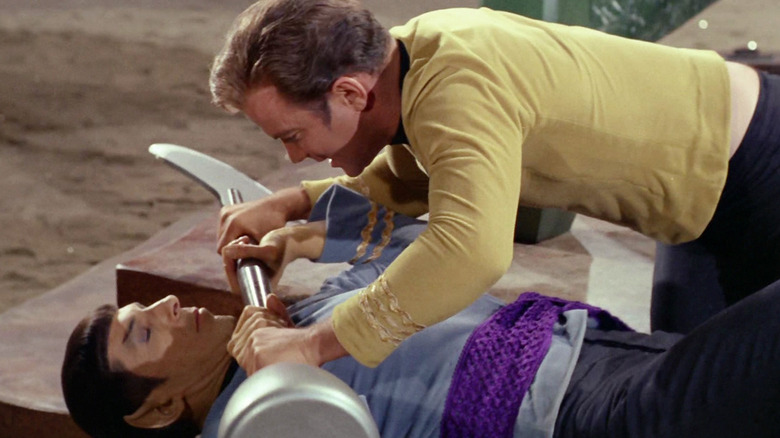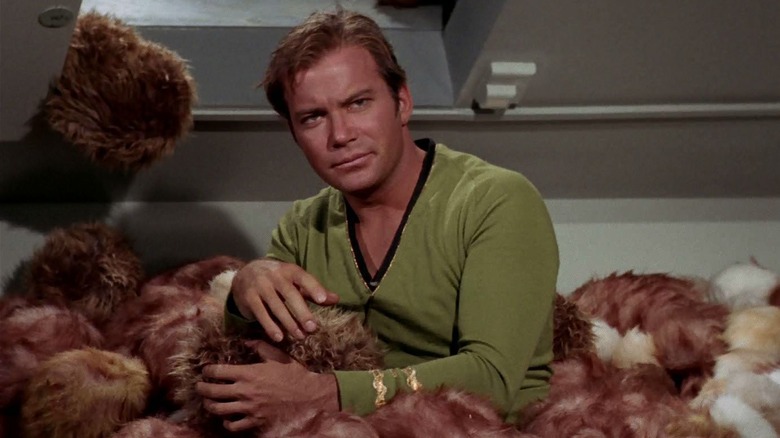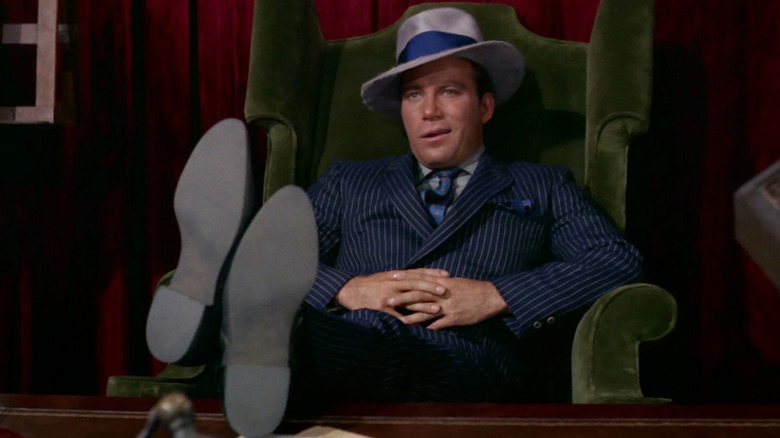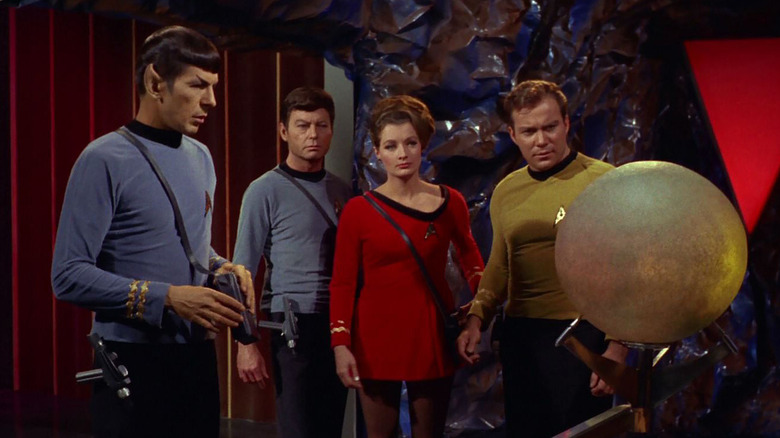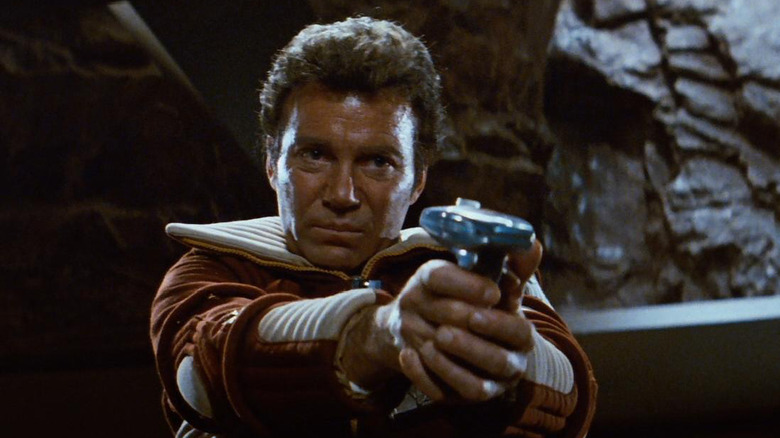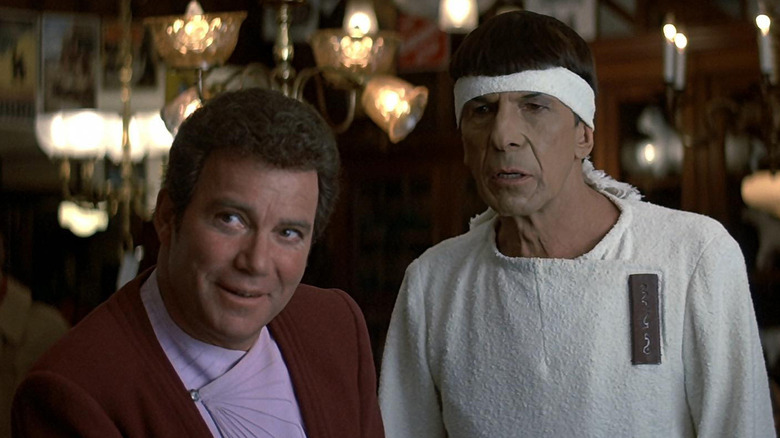Star Trek Episodes That Will Make You Love James T. Kirk
"Star Trek: Strange New Worlds," the new hit series on Paramount+, revisits the five year mission of the USS Enterprise as commanded by Captain Christopher Pike, played by the absolutely lovable Anson Mount. Pike has endeared himself to fans by being the space dad of our dreams, a sweetheart who leads the Enterprise family by consensus and is always ready to support his crew with a kind ear and a bowl of pasta mama. So, when his successor, James T. Kirk, makes a surprise guest appearance on the first season finale, "A Quality of Mercy," Kirk comes across a bit cold and stiff by comparison.
While new Kirk actor Paul Wesley may not have made a strong impression with his version of the character just yet, there are plenty of episodes of "Star Trek: The Original Series" that can serve as a great introduction to space sci-fi's most famous captain. While certainly a product of the time in which he was created, Jim Kirk as originally portrayed by William Shatner is a remarkable and textured leading man, as capable of warmth and compassion as Pike but also burdened with the expectations of stern, authoritative 1960s masculinity. With Pike now existing as a reimagined, refurbished midcentury man, Kirk becomes all the more fascinating by comparison.
Here's a selection of standout episodes that demonstrate what made James T. Kirk such a beloved and memorable character, and why he's still some Trekkies' favorite captain of the Enterprise.
Where No Man Has Gone Before
"Strange New Worlds" picks up the adventures of Captain Pike, Number One, and Lt. Spock, all originally created for the first Star Trek pilot in 1965. When this pilot was rejected and Pike actor Jeffrey Hunter declined to return for a second attempt, Star Trek creator Gene Roddenberry retooled the series around a new character, Captain James T. Kirk, portrayed by Canadian actor William Shatner. While this might be surprising to fans of "Strange New Worlds," Shatner's Kirk is actually a warmer, softer character than Hunter's Pike. The second pilot, "Where No Man Has Gone Before," introduces Kirk not only as a brave Starfleet Captain but as a caring friend, and presents him with a dilemma that pits these obligations against each other.
When we first meet James Kirk, he's not on giving orders on the bridge of the Enterprise, but invested in a friendly three-dimensional chess game against his first officer, Mr. Spock. As the story unfolds, Kirk confronts a challenge to another of his close friendships, when a mysterious space phenomenon endows his mentee Gary Mitchell with godlike powers and an arrogance to match. With Mitchell growing more powerful and more dangerous by the hour, can Kirk find a way to save both the Enterprise and his friend? If not, does he have the strength to do what's necessary?
While the triumvirate of "The Original Series" wouldn't be complete until the addition of Dr. Leonard "Bones" McCoy in the series proper, "Where No Man Has Gone Before" is also a first taste at the famous dynamic between Kirk and Spock, a constant push and pull between instinct and logic that would define both characters for decades to come.
The Corbomite Maneuver
All Starfleet captains, regardless of which series they're from, share certain noble characteristics. They're fearless, curious, and compassionate people, the finest examples of humanity even if they're not actually human themselves. Starfleet may prize truthfulness as its highest value, but there are times when scrupulous honesty can put a Captain or their crew at a disadvantage, and this is where James T. Kirk has the edge. When Kirk can't win the day by playing the rules, he's got no qualms against bending, breaking, or outright changing them to achieve victory.
In "The Corbomite Maneuver," the Enterprise is confronted by a massive alien craft whose captain, Balok, threatens to destroy them for accidentally intruding on his territory. Kirk faces an opponent who refuses to negotiate and has him both outmaneuvered and outgunned. He knows he can't beat Balok at his own game, but rather than admit defeat, he decides to try and bluff his way to victory, turning this from an interstellar chess match into poker. Kirk may not be holding the winning hand, but he doesn't need it so long as he has the confidence and cunning to convince his opponent otherwise.
Kirk shows off this talent for talking his way out of trouble numerous times throughout the series, but no episode better encapsulates his unique daring and charisma than "The Corbomite Maneuver," making it the most essential Kirk episode in all of Star Trek.
Balance of Terror
To fans of "Strange New Worlds," the classic 1966 episode "Balance of Terror" should be instantly familiar. This is the story to which Captain Pike is catapulted through time in the first season finale, "A Quality of Mercy." Here, the USS Enterprise is called to respond to an crisis on an old Earth border outpost, which has been destroyed in a sneak attack by their ancient enemy, the Romulan Empire. Just like in "A Quality of Mercy," the Enterprise must race to catch the cloaked Romulan vessel before it escapes into its home territory, but with Kirk in the captain's chair, the rest of the story plays out a bit differently.
"Balance of Terror" is a great submarine story in space that highlights the senselessness of military conflict, but it's also a great showcase for Jim Kirk as both a commander and as a human being. In times of overwhelming pressure, the crew of the Enterprise looks to their captain for stability and certainty, and it's Kirk's job to give it to them. Of course, deep down, he's as vulnerable and imperfect as everyone else, but he hides his self-doubt from his subordinates in order to protect both his image and their confidence.
The episode's true stroke of genius is when the perspective shifts to show us that the commander of the Romulan vessel is coping with that same stress. While Kirk may be more aggressive than Pike, he's still capable of seeing himself in his opponent. "Balance of Terror" challenges its audience to do the same, and recognize that one's true enemy is rarely the person across from them but the circumstances that put them at odds in the first place.
Arena
Though all of Star Trek's captains have seen their share of battle, none are as famous for throwing down as James T. Kirk. Like all good Starfleet officers, his goal is coexistence, not conquest, but he's also the last guy you'd want to challenge to a space battle or an old-fashioned fistfight. Kirk is unrelenting in any contest, armed with a sharp wit, a stiff punch, and a flagrant disregard for his own wardrobe.
Kirk finds himself locked in a number of life-and-death struggles throughout "The Original Series," and the most famous is his duel with the unnamed Gorn captain in the first season episode "Arena." After chasing his warship from the scene of a massacre at a Federation outpost, Kirk is trapped with his reptilian foe on the surface of a barren desert planet. Kirk has no weapons and no hope of defeating the Gorn hand-to-hand, and must use his intelligence and local resources to construct a means of victory. (This episode was released 20 years before the movie "Predator.") Of course, the Gorn of "The Original Series" isn't nearly as cool or scary than the reimagined version confronted by Pike's crew in "Strange New Worlds," but the campy aliens portrayed by stunt actors in rubber suits is part of the charm of classic Trek.
"Arena" may have the setup of a bloody action movie, but this is still Star Trek, and the episode's final message is one of peace and mercy. Kirk is a warrior, no question, but like all Starfleet heroes, he knows war is only ever a last resort.
A Taste of Armageddon
Not all of Jim Kirk's habits have aged terribly well, and one of them is nearly inseparable from the basic structure of "Star Trek." In the classic "Trek" formula, the alien cultures encountered by the Enterprise crew represent contemporary issues faced by the viewing audience, while Kirk and company represent an evolved future humanity that has already grown beyond them. Therefore, it's part of Kirk's narrative purpose to show up on some alien's doorstep and try to explain to them why their society is somehow broken. This often comes across as distastefully self-righteous, especially when he takes the job one step further and unilaterally upends an entire civilization so that they have no choice but to change their ways. No individual has the right to tell millions of people how to live their lives. However, Kirk's one-man revolutions are occasionally very cathartic as a power fantasy for viewers.
Nowhere is that more true than in "A Taste of Armageddon," in which Kirk and the Enterprise are declared as casualties in a simulated war between the planets Eminiar VII and Vendikar. The two worlds have been at war for centuries, so long that it's become a routine part of life. Rather than seek an end to their conflict, they've merely made it as convenient as possible, determining the death tolls of virtual bombings by computer and then ordering the citizens who have been "killed" to report to suicide booths. Kirk refuses to surrender his crew and decides to put a stop to this sanitized bloodbath once and for all, forcing Eminiar VII and Vendikar to choose between crafting a real peace or waging a real war.
Kirk may overstretch his authority, but he's never content to allow evil to triumph through his inaction.
The City on the Edge of Forever
If you mainly know Jim Kirk through cultural osmosis (or from the J.J. Abrams reboot), then you're likely aware of his reputation as a horndog. While it's true that Kirk has a lot of one-episode love interests over the course of the show's three seasons, the perception that he's led by his hormones has been greatly exaggerated through decades of parody and imitation. His behavior towards women doesn't always hold up terribly well through a modern lens — just as plenty of "romantic" storylines from the past can read as subtly or overtly predatory — but his fast and brief entanglements are a product of the show's format, not the character's intentions.
Jim Kirk might never find a partner who he loves more than the Enterprise (unless you count Spock), but there's one woman in particular who truly steals his heart. In the acclaimed episode "The City on the Edge of Forever," Kirk, Spock, and McCoy are thrown back in time to the early 1930s, where Jim meets a visionary social worker named Edith Keeler. Jim falls deeply in love with Edith for her generosity and brilliance, but destiny has other plans for both of them.
The romance with Edith allows us a glimpse at the quiet and tender side of Jim Kirk, the part of him that might have been satisfied living a more normal life away from the grave responsibilities of command. But, it's those very same responsibilities that keep Jim and Edith apart, as their respective roles in the future make their continued relationship impossible.
Amok Time
Mr. Spock may have gone on to feature in many stories without Captain Kirk — alongside the likes of Jean-Luc Picard, Michael Burnham, and Christopher Pike — but it's still very hard to imagine Captain Kirk without Mr. Spock. On "The Original Series," Kirk, Spock, and McCoy essentially act as three parts of a single character, with Spock representing pure logic, McCoy representing raw emotion, and Kirk representing the reason necessary to reconcile the two. The friendship between them is the beating heart of the show, and Kirk's loyalty to Spock is one of his most endearing characteristics as well as the source of his most shining moments.
In "Amok Time," Spock is struck by pon farr, the irresistible urge to return home to Vulcan to mate with his estranged wife, T'Pring. Since pon farr can be fatal if not satisfied, Kirk violates direct orders from Starfleet to rush Spock back to Vulcan. The situation gets more complicated when T'Pring announces that she's selected a new mate: Kirk. This twist leads the friends into mortal ritual combat, during which Kirk must find a way to save both himself and his friend, whose condition has driven him mad beyond reason.
Kirk may not let most of his crew as close to his heart as Christopher Pike does on "Strange New Worlds," but he'll still go to any lengths to protect them, and that goes double for Spock. Their bond is unbreakable by time or death, and is part of what makes them two of the greatest television characters of all time.
The Trouble with Tribbles
There's no denying that Jim Kirk is arrogant and self-important, and that this can be an obstacle to enjoying him as a character. So, it's no surprise that one of the most famous and beloved episodes of "Star Trek: The Original Series" shows Kirk being knocked down a peg and thrust into a truly embarrassing situation. In "The Trouble with Tribbles," the Enterprise is assigned to protect a crate full of grain bound for a disputed planet, a task for which Kirk believes he is utterly overqualified. The mission becomes further complicated when both the Enterprise and the nearby space station become infested with adorable, rapidly-multiplying critters called Tribbles. Add in a dust-up with the Klingons and the incessant complaining of an agricultural bureaucrat, and you're looking at James T. Kirk's most agonizing and humiliating workweek ever.
"The Trouble with Tribbles" is the first attempt to twist "Star Trek" into the shape of a workplace comedy, a genre in which many subsequent series have dabbled since. (The animated "Star Trek: Lower Decks" is basically "The Trouble with Tribbles: The Series.") Here, Kirk is a put-upon middle manager presiding over a fiasco that's outside his interests and beyond his control. Rarely have Kirk and company been more relatable than here, far from the high stakes and moral dilemmas of most episodes. It sucks, but they're trying their best to enjoy themselves at work.
It helps that William Shatner and the entire cast are in rare form in this episode, clearly relishing the chance to show off their versatility as comic actors. The success of "The Trouble with Tribbles" would assure that the franchise would afford them more such opportunities in the future, to varying degrees of success.
A Piece of the Action
If "The Trouble with Tribbles" is a story in which Captain Kirk is forced to take a silly situation seriously, "A Piece of the Action" lets Kirk — not just William Shatner, but Kirk himself — dive headfirst into the silliness. In this episode, the Enterprise makes contact with an alien planet and discovers that, thanks to the accidental influence of an Earth ship a century prior, its society has modeled itself into a caricature of 1920s Gangland Chicago. The people of Sigma Iotia II wear pinstripe suits, carry Tommy guns, and speak in the cartoonish slang of early James Cagney talkies.
Where Kirk spends "The Trouble with Tribbles" under the tiresome supervision of Federation bureaucrats, "A Piece of the Action" lets him tackle this bizarre scenario as he pleases, and he chooses to simply go with it. By the end of the episode, Kirk is dressed up in a period outfit and doing a funny voice, and he's got Spock doing it, too. While his strategy for repairing the cultural contamination of Sigma Iotia II once again sees him overreaching his authority by light years, it's undeniably fun to watch him confront an absurd problem by equally absurd means.
Moreover, "A Piece of the Action" represents a quality of the original "Star Trek" that so many of its descendants have struggled to recapture: It lets you have fun with the characters. "Star Trek" is and should be serious business a lot of the time, but ending the occasional episode on a punchline and a freeze frame can be a breath of fresh air that brings the audience a little closer to the characters.
Return to Tomorrow
If you're familiar with "Return to Tomorrow," you might find it a surprising inclusion on a list of episodes about Captain Kirk. After all, Jim spends much of the hour possessed by the spirit of another life-form, the ancient alien Sargon. In this story, Kirk, Spock, and astro-biologist Lt. Commander Ann Mulhall agree to allow three non-corporeal beings to inhabit their bodies while they construct their new, permanent robot forms. The plan goes awry, of course, putting all three officers' lives in jeopardy and leaving Jim Kirk's mind trapped in a glowing plastic sphere for a solid twenty minutes.
However, it's what Kirk does in the first half of the episode that solidifies it as one of his best, as he delivers a passionate speech about the value of embracing danger for the sake of discovery. Lending a helping hand to three stranded immortals has a value beyond simple decency, as the androids that Sargon plans to create represent a massive scientific breakthrough for the Federation. Kirk argues that this is exactly the sort of danger that he and all of Starfleet exists to face.
"Risk is our business," Kirk concludes. "That's what this starship is all about. That's why we're aboard her."
In the space of 100 seconds, Captain Kirk succinctly summarizes the spirit of adventure and curiosity that drives all of "Star Trek," a rousing call to action who all who are willing to take a chance on a better tomorrow.
Star Trek II: The Wrath of Khan
While his 79 episodes of "Star Trek: The Original Series" allowed audiences to explore multiple facets of Captain James T. Kirk, the conventions of 1960s television made it impossible for him to demonstrate any real growth. Kirk is always the same man at the beginning of every episode of "Star Trek," no matter what happened the week before. It wasn't until the feature film series, which began a decade after the TV show was canceled, that Kirk was afforded the luxury of deconstruction and evolution.
1982's "Star Trek II: The Wrath of Khan" finds a now Admiral Kirk suffering from a mid-life crisis. "The Wrath of Khan" takes each criticism one might have of Kirk on "The Original Series" and turns them into a new challenge. Because he's routinely cheated death, he doesn't know how to face it. Because he's married to his work, he's never met his son. And because he rides off into the sunset after each adventure without ever looking back, he's left a huge mess in his wake. When Khan, the antagonist from a classic episode that Kirk has all but forgotten, comes looking for revenge, Kirk must face the dire consequences of his arrogance.
Even 40 years later, "Wrath of Khan" remains the single essential film in the entire Star Trek franchise, not only for being a rousing adventure in its own right, but for humanizing one of television's most legendary characters better than any story before or since.
Star Trek IV: The Voyage Home
After three more sober installments of the feature film series, "Star Trek IV: The Voyage Home" was the first to deliberately engage in the light-hearted fun of the classic show's comedy episodes. The story sends Kirk, Spock, and company to the contemporary setting of 1984 San Francisco to retrieve a pair of humpback whales and bring them forward to save the future. In contrast to the rest of the films in the franchise, "The Voyage Home" has no deliberate violence, only an urgent mission of peace and a lot of silly, fish-out-of-water comedy.
William Shatner and Leonard Nimoy spend much of the film as a vaudeville-style double act, with Kirk trying to fake his way though the modern world and Spock making zero effort to blend in. This is Shatner and Nimoy at their most adorable and entertaining, playing off of each other with an ease that can only be achieved with years of experience working together. Shatner also enjoys terrific chemistry with Catherine Hicks as marine biologist Dr. Gillian Taylor, portraying Kirk at his sweetest and most charming.
If "Wrath of Khan" is the film that deconstructs James T. Kirk, then "The Voyage Home" is the film that puts him back together, restoring the sense of joy and adventure that has made him a beloved icon for over 50 years.
